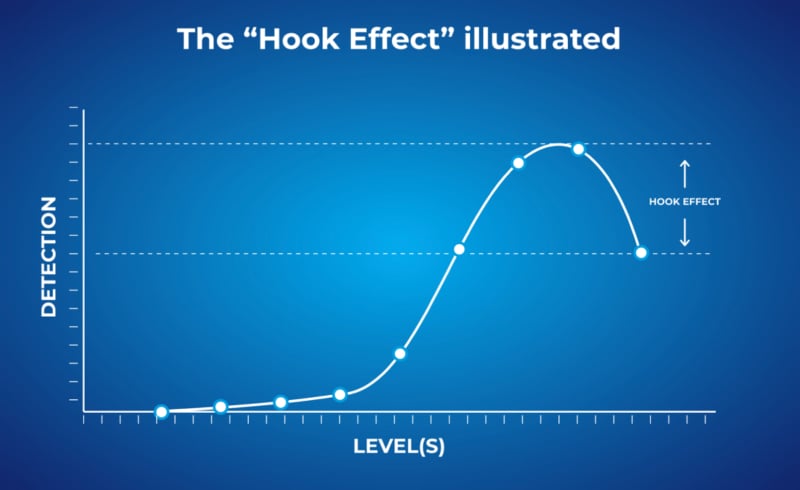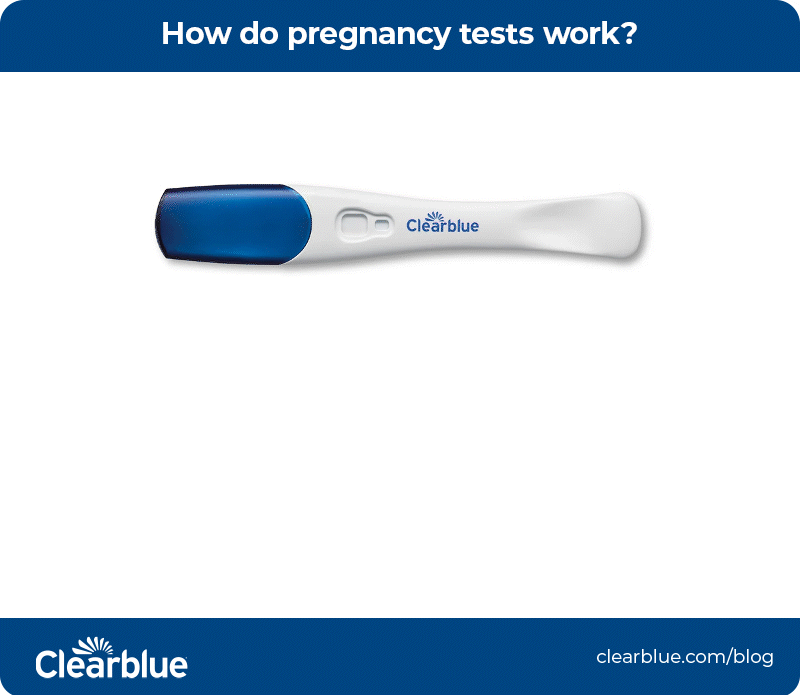Hook effect in pregnancy test results: Understanding this rare false negative

Do you feel pregnant, but your pregnancy test is negative? It is possible to experience pregnancy symptoms but get a negative test result. While the early signs of pregnancy (think fatigue, nausea, appetite changes, more frequent urination, bloating and weight changes, and breast changes1) are common symptoms of PMS, there is a rare chance the negative test is caused by something called the hook effect.
What is the hook effect?
Generally speaking, the hook effect refers to a false-negative result in a test designed to detect a specific substance — a false negative caused by an overabundance of the substance the test is looking for.2 The hook effect can occur in tests that measure proteins, antibodies, antigens or other substances — like the human Chorionic Gonadotropin (hCG) hormone measured in urine or blood pregnancy tests.2 It may seem counterintuitive that “too much” hCG could result in a false-negative test, but the reasoning has to do with the chemistry of how pregnancy tests work.

You can see the “hook” pattern form as hormone levels increase and overwhelm the test’s ability to detect them.
What causes the hook effect in pregnancy test results?
In rare cases, hCG levels are so high that they can essentially overwhelm a pregnancy test, leading to a false negative result due to the hook effect. How high are we talking? The hook effect can occur when hCG levels are above 500,000 mIU/mL.3 The hook effect in pregnancy tests is rare.4 While hCG levels can vary greatly from person to person, in a typical pregnancy, hCG levels may peak around week 10 at around 100,000 mIU/mL.5 We discuss why some people have such high hCG levels during pregnancy below.
But first, to understand why high levels of hCG could potentially affect a home pregnancy test, it’s important to understand how home pregnancy tests work.
Imagine you are pregnant and you take a home pregnancy test. Here’s how the urine sample travels through the test area:

- Sample pad: The sample pad, located in the tip of the pregnancy test, absorbs your urine. Because you’re pregnant, hCG (produced by the placenta) is released into your blood, and will be present in your urine. Shortly after implantation, it should be present at a detectable level in your urine.
- Antibodies: The hCG in your urine will bind to mobile antibodies in the test. The mobile antibodies are attached to colored particles (these could be blue or red depending on the test).
- Test line: Immobilized antibodies in the test zone attach to hCG (at this point, hCG is attached to the antibodies on the colored particles). This forms a positive line. (If you are not pregnant, no line will form.)
- Control window: Excess colored particle-antibody complex flows here. This area of the pregnancy test contains antibodies that recognize the colored particle-antibody complex and will bind to it. This causes a line to form so you know the test is working correctly.
What causes high hCG levels?
High levels of hCG can occur for several reasons, including miscalculating the date of the start of your pregnancy, being pregnant with multiples or having a molar (nonviable) pregnancy.5-8 The only way to determine your hCG level is to have your blood drawn and tested by a healthcare provider. Home pregnancy tests are qualitative, which means they only detect whether hCG is present, not how much hCG may be present. Quantitative tests, which measure the amount of hCG in your blood, are typically only done at your doctor’s office.
Even if your hCG levels are elevated, a false-negative pregnancy test result caused by the hook effect is rare. Why? Let’s look at the three most common causes of high levels of hCG:
- Miscalculating your conception date: When you’re pregnant, your hCG levels (which, remember, vary greatly from person to person) will increase by about 50% each day during the first 10 weeks, peak at around week 10 and then slowly decline.5 While it’s difficult to apply a number to anyone’s hCG levels during pregnancy, the American Pregnancy Association says hCG levels can peak at around 288,000 mIU/ml during weeks 9-12. Still, that’s nowhere near the 500,000 mIU/ml or 1,000,000 mIU/ml experts say is needed to cause the hook effect in a pregnancy test.
- Multiple pregnancy: It’s possible to have higher levels of hCG when pregnant with multiples, but even so, it may not be enough to cause the hook effect in a pregnancy test. Because a person’s individual hCG levels can vary so much, an ultrasound is the best determination of a multiple pregnancy.6
- Molar pregnancy: A molar pregnancy occurs when an abnormal fertilized egg develops into something called a hydatidiform mole instead of a fetus. Molar pregnancies are rare but require prompt treatment. Those who experience molar pregnancy likely feel pregnant, although their abdomen may become larger more quickly than in a normal pregnancy. Severe nausea, vomiting and vaginal bleeding are also common, as is passing tissue through the vagina. Molar pregnancy can cause very high levels of hCG, enough to trigger the hook effect in a pregnancy test result. If you feel pregnant, have a negative pregnancy test and experience any of these symptoms, contact your doctor immediately.7,8
What should I do if I suspect the hook effect in a pregnancy test result?
So what happens if your period doesn’t arrive, your test is negative and you still feel pregnant? First, consider your timing. If you tested from the day you expect your period, your Clearblue® test is over 99% accurate.9 Try taking a test again in three days’ time, as you may have miscalculated when your period is due — menstrual cycles can vary for myriad reasons. Not using your first morning urine or drinking too much liquid before taking a home pregnancy test can also affect your results. In rare cases, an ectopic pregnancy (which is different from a molar pregnancy) may give a negative pregnancy test result.10
Resist the temptation to “hack” your home pregnancy test
You may have come across online hacks for avoiding the hook effect — they sometimes recommend diluting your urine or testing later in the day. But there is little evidence that these hacks will help you avoid the rare hook effect in a pregnancy test result, so we don’t recommend it. The best thing you can do to ensure an accurate home pregnancy test result is to follow the instruction leaflet directions, and if you have any concerns, reach out to your doctor.
Remember: The hook effect is very rare, and the hCG levels required to cause the hook effect in a pregnancy test result are extremely high. If you have a negative pregnancy test result and are still concerned, contact your doctor.
Related Articles
Sources :
- The American College of Obstetricians and Gynecologists. Changes during pregnancy. Accessed December 12, 2022 https://www.acog.org/womens-health/infographics/changes-during-pregnancy
- Ross G, Filippini D, Nielen M, Salentijn G. Unraveling the hook effect: a comprehensive study of high antigen concentration effects in sandwich lateral flow immunoassays. Anal. Chem. 2020;92(23):15587-15595. doi: 10.1021/acs.analchem.0c03740. Accessed December 12, 2022. https://pubs.acs.org/doi/10.1021/acs.analchem.0c03740
- Betz D, Fane K. Human chorionic gonadotropin. StatPearls. 2022. Accessed December 12, 2022. https://www.ncbi.nlm.nih.gov/books/NBK532950/
- Priyadarshini S, Manas F, Prabhu S. False negative urine pregnancy test: hook effect revealed. Cureus. 2022;14(3). doi: 10.7759/cureus.22779. Accessed March 22, 2023. https://www.cureus.com/articles/87825-false-negative-urine-pregnancy-test-hook-effect-revealed#!/
- Gnoth C, Johnson S, Strips of hope: accuracy of home pregnancy tests and new developments. Geburtshilfe Frauenheilkd. 2014;74(07):661-669. doi: 10.1055/s-0034-1368589. Accessed December 12, 2022 https://www.ncbi.nlm.nih.gov/pmc/articles/PMC4119102/
- March of Dimes. Being pregnant with twins, triplets and other multiples. Updated June 2021. Accessed December 12, 2022 https://www.marchofdimes.org/find-support/topics/pregnancy/being-pregnant-twins-triplets-and-other-multiples
- Ramirez PT, Salvo G. Merck Manual Consumer Version. Molar pregnancy. Updated September 2022. Accessed December 12, 2022 https://www.merckmanuals.com/home/women-s-health-issues/cancers-of-the-female-reproductive-system/molar-pregnancy
- Soper JT. Gestational trophoblastic disease: current evaluation and management. Obstet Gynecol. 2021;137(2);355-370. doi: 10.1097/AOG.0000000000004240. Accessed December 12, 2022. https://journals.lww.com/greenjournal/Fulltext/2021/02000/Gestational_Trophoblastic_Disease__Current.22.aspx
- Over 99% accurate from the day you expect your period. >99% accurate at detecting typical pregnancy hormone levels. Note that hormone levels vary. See insert.
- Kopelman ZA, Keyser EA, Morales KY. Ectopic pregnancy until proven otherwise … even with a negative serum hCG test: a case report. Case Rep. Women’s Health. 2021;30. doi: 10.1016/j.crwh.2021.e00288. Accessed December 12, 2022. https://www.sciencedirect.com/science/article/pii/S2214911221000047?via%3Dihub

Find out more about pregnancy tests

How to use a pregnancy test
When and how you can test depends on the test you use, but in this article you will find everything you need to know before starting a test.




